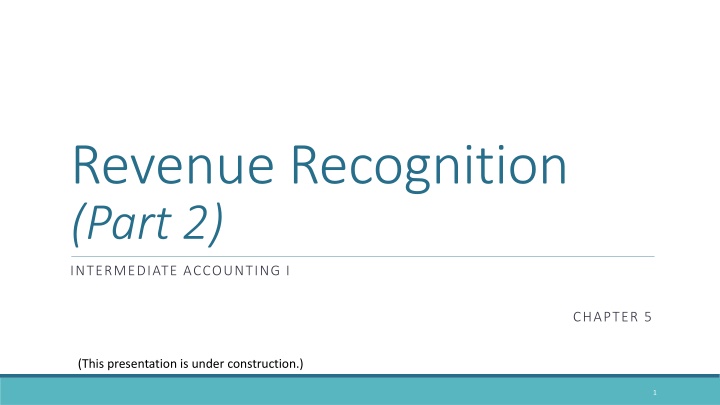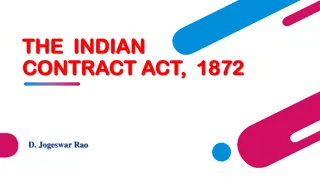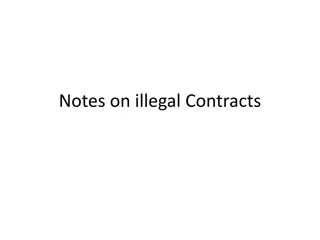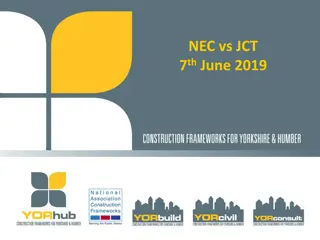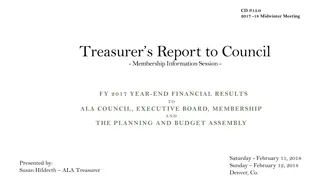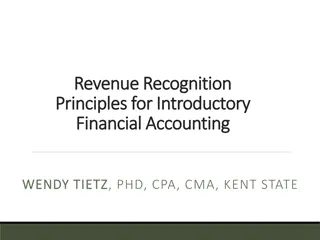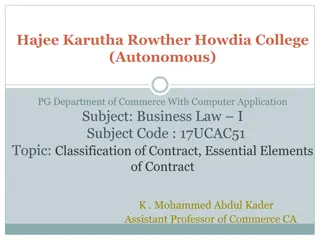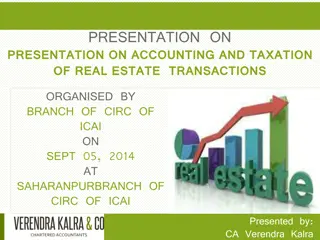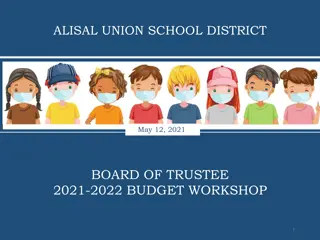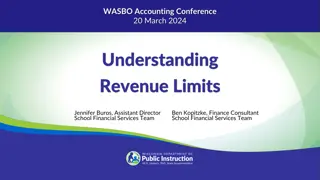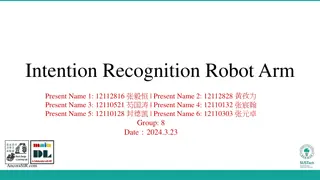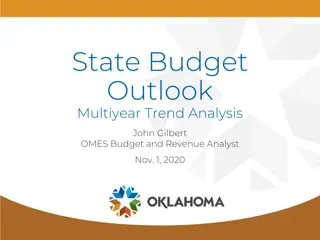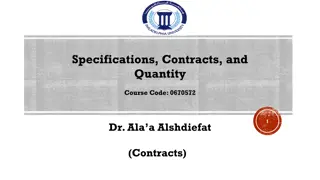Revenue Recognition for Long-Term Contracts in Construction
Long-term contracts in construction projects require specific accounting methods for revenue recognition. This presentation explores the principles behind revenue recognition for long-term contracts, including the Completed Contract Method. Examples and journal entries illustrate the accounting treatment for costs, billings, and collections over the contract period.
Download Presentation

Please find below an Image/Link to download the presentation.
The content on the website is provided AS IS for your information and personal use only. It may not be sold, licensed, or shared on other websites without obtaining consent from the author.If you encounter any issues during the download, it is possible that the publisher has removed the file from their server.
You are allowed to download the files provided on this website for personal or commercial use, subject to the condition that they are used lawfully. All files are the property of their respective owners.
The content on the website is provided AS IS for your information and personal use only. It may not be sold, licensed, or shared on other websites without obtaining consent from the author.
E N D
Presentation Transcript
Revenue Recognition (Part 2) INTERMEDIATE ACCOUNTING I CHAPTER 5 (This presentation is under construction.) 1
LONG LONG- -TERM CONTRACTS TERM CONTRACTS Exist when the product/service delivery occurs over a long period of time (longer than one fiscal period). Generally comprised of one performance obligation. Most long-term contracts qualify for revenue recognition over time There are two approaches to accounting for revenue and expense recognition for long term contracts: At a point in time when contract is completed (previously called the Completed Contract Method) Over a period of time (previously called the Percentage-of- completion Method) 2
ACCOUNTING FOR COSTS OF CONSTRUCTION ACCOUNTING FOR COSTS OF CONSTRUCTION AND ACCOUNTS RECEIVABLE AND ACCOUNTS RECEIVABLE All costs of construction and gross profit are recorded in an asset (inventory) account called Construction in Progress. Period billings are credited to a contra-asset account called Billings on Construction Contract. Costs of construction only are recorded in an expense account called Costs of Construction 3
COMPLETED CONTRACT METHOD COMPLETED CONTRACT METHOD No revenues or expenses are recognized until the project is complete. If a contract doesn t qualify for revenue recognition over time following the criteria specified in ASU 2014-09, revenue is recognized upon completion of the contract. (In prior GAAP, this was called the completed contract method.) The completed contract method does not properly portray a company's performance over the construction period and should only be used in unusual situations when forecasts of costs to complete the project are highly uncertain.. 4
COMPLETED CONTRACT METHOD Example At the beginning of 2013, the Harding Construction Company received a contract to build an office building for $5 million. The project is estimated to take three years to complete. According to the contract, Harding will bill the buyer in installments over the construction period according to a prearranged schedule. Information related to the contract is as follows: 2013 2014 2015 Totals Construction costs incurred during the year Billings made during the year Cash collections during year $1,500,000 $1,000,000 $1,600,000 $1,200,000 $2,000,000 $1,800,000 $5,000,000 1,000,000 1,400,000 2,600,000 $4,100,000 5
COMPLETED CONTRACT METHOD Journal Entries Costs, Billings & Collections (2013) Construction in Progress 1,500,000 Various Accounts 1,500,000 To record construction costs Accounts Receivable 1,200,000 Billings on Construction Contract 1,200,000 To record progress billings Cash 1,000,000 Accounts Receivable 1,000,000 To record cash collections Repeat these entries for 2014 and 2015 using the appropriate data for each year. 6
COMPLETED CONTRACT METHOD Journal Entries Completed Contract (2015) Construction in Progress (gross profit) 900,000 Cost of Construction (total cost) 4,100,000 Revenue from Long-term Contracts To record gross profit 5,000,000 Billings on Construction Contract 5,000,000 Construction in Progress 5,000,000 To record transfer of finished asset 7
PERCENTAGE OF COMPLETION METHOD PERCENTAGE OF COMPLETION METHOD Allocates a fair share of a project's revenues and expenses to each reporting period during construction. The allocation of project profit is accomplished by estimating progress to date. Progress to date (the percentage of completion) can be estimated as the proportion of the project's cost incurred to date divided by total estimated costs, by project milestones, or by relying on an engineer's or architect's estimate. To determine periodic gross profit, the percentage of completion is multiplied by estimated gross profit to determine gross profit earned to date, and then the current period's gross profit is determined by subtracting from this amount the gross profit recognized in previous periods. Periodic revenues are determined by multiplying the percentage of completion by the total contract price and then subtracting revenue recognized in prior periods. In most cases, the cost of construction equals the construction costs incurred during the period. 8
PERCENTAGE OF COMPLETION METHOD PERCENTAGE OF COMPLETION METHOD Gross Profit Recognized This Period Estimated Gross Profit Percent Complete Contract Price (Actual Costs to Date + Est Costs to Complete) Actual Costs Incurred/ (Total Actual Costs + Estimated Costs to Date) (Total Est Gross Profit X Percentage Completed to Date) Gross Profit Recognized in Prior Periods 9
COMPLETED CONTRACT METHOD Example At the beginning of 2013, the Harding Construction Company received a contract to build an office building for $5 million. The project is estimated to take three years to complete. According to the contract, Harding will bill the buyer in installments over the construction period according to a prearranged schedule. Information related to the contract is as follows: Construction costs incurred during the year Construction costs incurred in prior years Cumulative construction costs Estimated costs to complete at end of year Total estimated and actual construction costs Billings made during the year Cash collections during year 2013 2014 2015 $1,500,000 $1,000,000 $1,600,000 - 0 - 1,500,000 2,500,000 1,500,000 2,500,000 4,100,000 2,250,000 1,500,000 - 0 - $3,750,000 $4,000,000 $4,100,000 $1,200,000 1,000,000 $2,000,000 $1,800,000 1,400,000 2,600,000 10
PERCENTAGE OF COMPLETION METHOD Journal Entries Costs, Billings & Collections (2013) Construction in Progress 1,500,000 Various Accounts 1,500,000 To record actual construction costs incurred Accounts Receivable 1,200,000 Billings on Construction Contract 1,200,000 To record progress billings Cash 1,000,000 Accounts Receivable 1,000,000 To record cash collections Repeat these entries for 2014 and 2015 using the appropriate data for each year. 11
PERCENTAGE OF COMPLETION METHOD Journal Entries Gross Profit (2013) click for gross profit calculation Construction in Progress (gross profit) 500,000 Cost of Construction (actual costs) 1,500,000 Revenue from Long-term Contracts (costs + profit) To record gross profit 2,000,000 1) Estimated Gross Profit: Contract Price (Actual Costs to Date + Est Costs to Complete) $5,000,000 (1,500,000 + 2,250,000) = $1,250,000 2) Percent Complete Actual Costs Incurred / (Actual Costs + Est Costs to Complete) $1,500,000 / (1,500,000 + 2,250,000) = 40% (Est Gross Profit X Percent Complete) Gross Profit Recog in Prior Periods 3) Gross Profit Recognized: $1,250,000 X 40% = $500,000 12
PERCENTAGE OF COMPLETION METHOD Journal Entries Gross Profit (2014) click for gross profit calculation Construction in Progress (gross profit) 125,000 Cost of Construction (actual costs) 1,000,000 Revenue from Long-term Contracts (costs + profit) To record gross profit 1,125,000 1) Estimated Gross Profit: Contract Price (Actual Costs to Date + Est Costs to Complete) $5,000,000 (2,500,000 + 1,500,000) = $1,000,000 2) Percent Complete Actual Costs Incurred / (Actual Costs + Est Costs to Complete) $2,500,000 / (2,500,000 + 1,500,000) = 62.5% (Est Gross Profit X Percent Complete) Gross Profit Recog in Prior Periods 3) Gross Profit Recognized: $1,000,000 X 62.5% = $625,000 - $500,000 = $125,000 13
PERCENTAGE OF COMPLETION METHOD Journal Entries 2015 click for gross profit calculation Construction in Progress (gross profit) 275,000 Cost of Construction (actual costs) 1,600,000 Revenue from Long-term Contracts (costs + profit) To record gross profit 1,875,000 Billings on Construction Contract (account balance) 5,000,000 Construction in Progress (account balance) 5,000,000 1) Estimated Gross Profit: Contract Price (Actual Costs to Date + Est Costs to Complete) $5,000,000 (4,100,000 + 0) = $900,000 2) Percent Complete Actual Costs Incurred / (Actual Costs + Est Costs to Complete) $4,100,000 / (4,100,000 + 0) = 100% (Est Gross Profit X Percent Complete) Gross Profit Recog in Prior Periods 3) Gross Profit Recognized: $900,000 X 100% = $900,000 - $625,000 $275,000 14
PERCENTAGE OF COMPLETION METHOD Income Statement Presentation - 2013 Revenue from Long-term Contracts $2,000,000 Cost of Construction 1,500,000 Gross Profit $500,000 Note that the gross profit reported on the income statement is the same as that recorded in the journal for each reporting period. 15
PERCENTAGE OF COMPLETION METHOD Balance Sheet Presentation - 2013 Construction in progress is compared to billings on construction contract. A debit balance indicates costs (plus profits for the percentage-of-completion method) in excess of billings and is reported as an asset. A credit balance indicates billings in excess of costs (plus profits for the percentage-of-completion method) and is reported as a liability. 16
LONG-TERM CONTRACT PERIODIC LOSS Recall that total construction costs are only estimates until the contract is completed. A loss could occur on a profitable project if the estimated costs to complete were underestimated in prior periods. An estimated loss on a long-term contract is fully recognized in the first period that the loss is anticipated, regardless of the revenue recognition method used. Recognized losses on long-term contracts reduce the construction in progress account. 17
LONG-TERM CONTRACT LOSS ON OVERALL PROJECT An estimated loss on a long-term contract is fully recognized in the first period the loss is anticipated, regardless of whether revenue is recognized over time or upon completion. Cost of construction will not be equal to the cost incurred during the period but will consist of the amount of the loss recognized plus the revenue recognized. 18
GROSS PROFIT FOR COMPLETED CONTRACT GROSS PROFIT FOR COMPLETED CONTRACT AND PERCENTAGE AND PERCENTAGE- -OF OF- -COMPLETION METHODS COMPLETION METHODS Note that the same total amount of gross profit is recognized under the two methods; the only difference is timing. $ $ 19
Revenue Recognition INTERMEDIATE ACCOUNTING I CHAPTER 5 (Part 2) END OF PRESENTATION (This presentation is under construction.) 20
